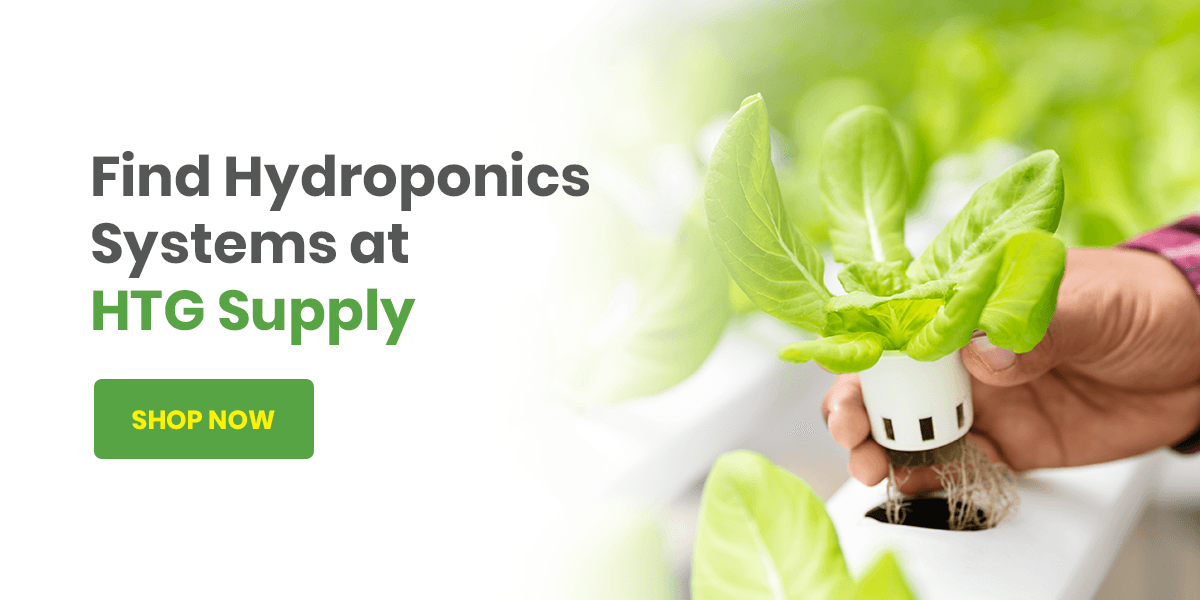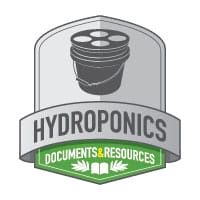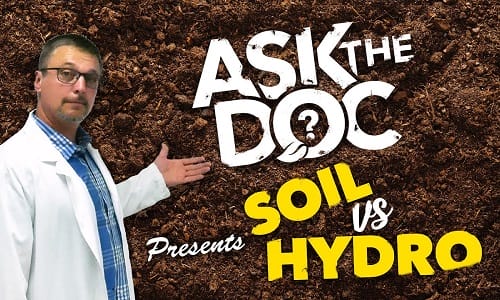If you’ve ever asked yourself, “How can I make a hydroponic system?” you have found a valuable resource here. Hydroponics provide an alternative to outdoor gardening that can be more efficient and allow for growth of plants outside their typical growing seasons. To get started with hydroponic systems, you need to know the basics of what these systems can and cannot do, the types and the various components required for creating your own.

What Is a Hydroponic System?
A hydroponic system is a method of growing that uses less water overall and no soil for plant production. Since this process can happen inside, you can grow plants throughout the year, regardless of the local growing climate. Many people turn to hydroponics as an environmentally friendlier means of growing, even if they don’t have the land or climate for an outdoor garden.
What Is Hydroponics?
The term hydroponics means “working water” in Latin. This origin gives some insight into how hydroponics systems work — they provide a means of growing plants without using soil. Instead of drawing nutrients from the soil, the plants get them from water. Because the system does not require watering soil, it uses much less water for growing than a conventional garden. To avoid overwatering plants grown with this method, the system requires careful setup, variable control and monitoring.
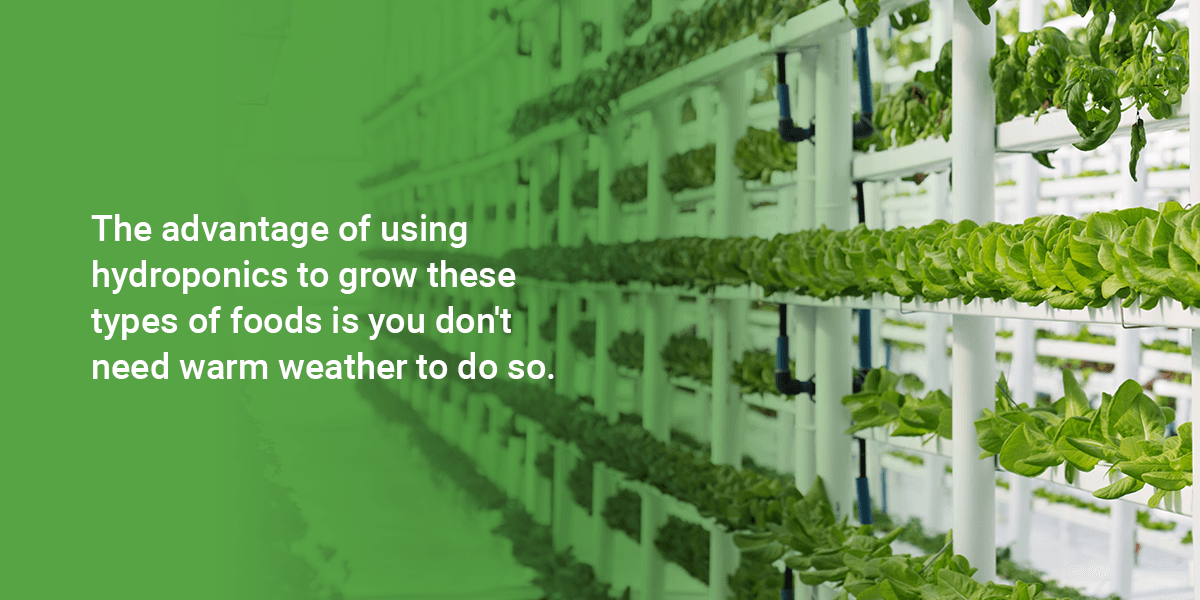
What Can Be Grown in a Hydroponic System?
When it comes to choosing what to grow in a hydroponic system, understand that some plants do better than others. For example, plants that require deep soil to grow into, such as root vegetables, don’t do well in the growth media, so stay away from potatoes and sweet potatoes. Instead, try some plants that grow well in hydroponics. Some high-performing plants for this growth method include:
- Spinach
- Lettuce
- Strawberries
- Herbs
- Bell peppers
- Blueberries
- Raspberries
- Cantaloupe
- Tomatoes
- Watermelons
- Grapes
The advantage of using hydroponics to grow these types of foods is you don’t need warm weather to do so. Bell peppers usually grow in the summer, while strawberries fruit after the frost in the spring. But you don’t have to wait until warm weather to enjoy freshly picked strawberries or peppers when you grow them in a hydroponic, year-round garden inside.
When growing vining fruits, make sure to have adequate support and light for them. These factors are crucial for success with heavy or tall plants such as grapes, cantaloupe and watermelon. You should prepare to train these vines to control where and how they grow. Doing so will ensure support and prevent these fruits from overwhelming your growing area.
Beginners should stick to leafy vegetables, such as spinach, herbs and lettuce, as these are the easiest to grow hydroponically. Vining plants are better for more advanced growers who want the extra challenge of producing larger plants.
What Are the Types of Hydroponics?
Hydroponic systems have six main forms:
- Aeroponics
- Ebb and flow
- Drip
- Deep water culture
- Nutrient film technique
- Wick system
All hydroponics systems use nutrients added to water, water pumps and net pots or hydroponic substrate. Some use loose growing media like coco coir while others, such as nutrient film techniques, may use only the original propagation media. Additionally, misting systems and air pumps are added features for some types of hydroponic methods.
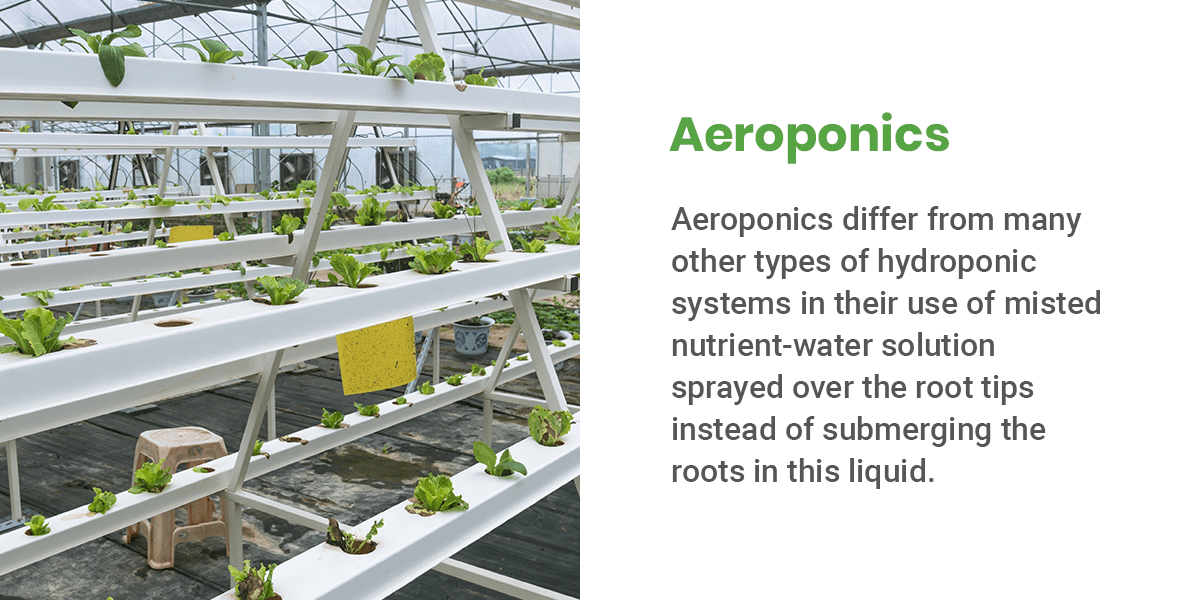
Aeroponics
Aeroponics differ from many other types of hydroponic systems in their use of misted nutrient-water solution sprayed over the root tips instead of submerging the roots in this liquid. Because these aerosolize the liquid nutrient solution, aeroponics tends to use less water than any other hydroponic system. This option is the best choice for growing in areas that experience frequent water use restrictions that might make outdoor gardening difficult.
Because the roots have exposure to the air, the plants can absorb more oxygen for better growth. Aeroponic solutions also let you grow a greater variety of plants. Tomatoes, bell peppers, watermelons, lettuce and strawberries thrive when grown with aeroponics. Plus, aeroponic systems are often more compact than other system types making them easy to relocate to different areas.
The biggest considerations to make with aeroponics are the cost and maintenance. This system requires strict control and monitoring of the misting system. If the nutrient solution pumps fail for any reason, the entire crop could die. You may need to be prepared to manually spray the roots with nutrient solution. Note the cost of setting up this type of system is higher than other DIY hydroponic systems, such as deep water culture.
Ebb and Flow
Another name for ebb and flow systems is flood and drain. These terms provide a definition for how these systems work. Plants sit in growth medium inside beds. These beds fill with nutrient solution from a pump that delivers water from below. The system includes a drain to allow the excess solution to flow out of the bed and prevent overflowing. Timers on the pump regulate how long the growing bed floods. When the timer stops, the solution in the bed drains out completely.
These systems are ideal for home hydroponic gardeners and can accommodate the needs of a large variety of plants. Due to the deeper beds, these types of systems can grow some root vegetables such as carrots. You can also grow larger plants like tomatoes, peas, bell peppers and beans in ebb and flow systems.
If you choose this system, watch out for pump or drain failure. If either of these systems does not deliver the nutrient solution to the growth medium or drain it properly, your plants could have their roots dry out or drown.
Drip System
The drip system delivers water directly to individual plants in the growth medium. The water can drain off in a non-recovery setup or return to the reservoir in a recovery setup. This system works best for working with plants that have individual needs or when the specific nutrient solution needs change.
This system is ideal for growing large plants, such as pumpkins, watermelons and cantaloupe. It also easily adapts to large-scale production. Note that this type of system is complex when making adjustments to get the perfect amount of nutrient solution to each plant. Therefore, it may not be best for those starting out with hydroponics for the first time.

Deep Water Culture (DWC)
The easiest system to start with in hydroponics is deep water culture. This system submerges the net pots that hold the plants’ roots into the water with an air stone that includes a bubbler to keep the roots constantly supplied with fresh oxygen. The DWC system is the simplest method to set up but requires regular monitoring of the airflow to ensure the plants have adequate oxygen.
For first-time growers, the DWC system is a perfect introductory method because it does not require expensive specialty equipment. But the plants you grow with DWC tend to have limits in size to leafy vegetables such as herbs, lettuce and spinach. Very large plants may have challenges growing well with this system. Additionally, you must monitor the water temperature to keep it just below room temperature, around 60 to 68 degrees Fahrenheit.
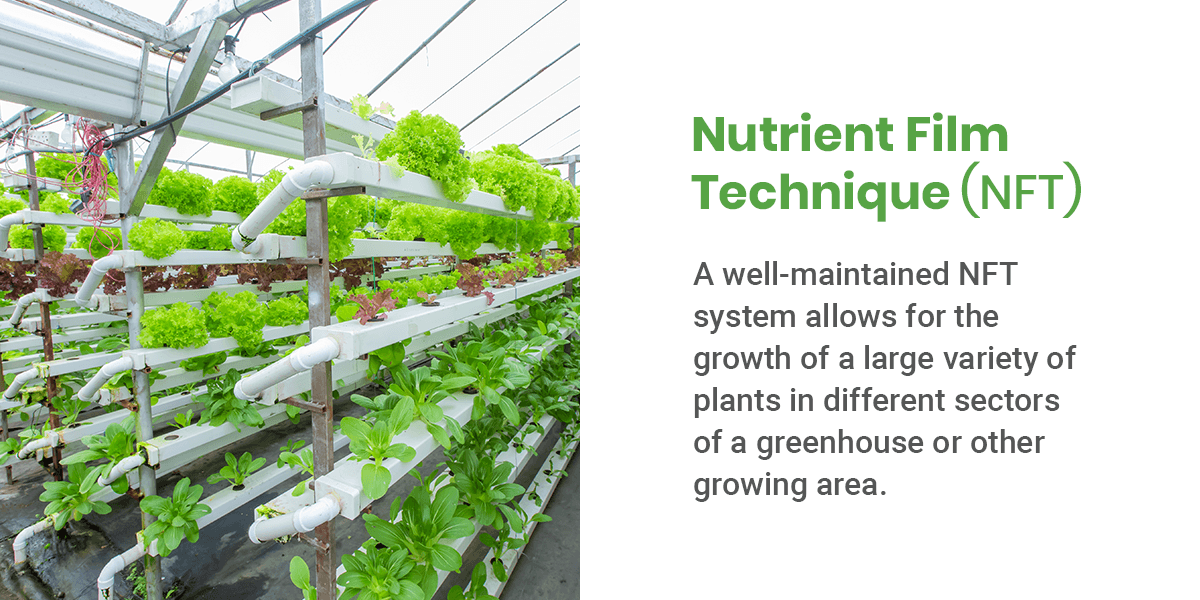
Nutrient Film Technique (NFT)
The nutrient film technique pumps a shallow channel of nutrient solution — the film — across the root tips of the plants. The slanted angle of the growing bed allows the solution to flow downward back to the reservoir where the pump recirculates it back to the plants. Because water constantly recirculates, NFT does not require as much freshwater as other systems that do not reuse water, such as non-recovery drip systems. To keep the water fresh, replace it weekly.
Common covered-channel type NFT systems use only the original propagation growing media to support the roots. Therefore, they require plants with short root systems. Lightweight plants like lettuce, strawberries, kale, herbs or spinach are ideal choices for these NFT setups.
One of the main concerns for NFT is the spacing of plants. This method requires monitoring to prevent the plants’ roots from growing too deeply and blocking the nutrient solution flow in the channel.
Another concern for this method is the angle of the channel. A channel that is too steep does not allow the plants to get enough water and nutrients. The opposite happens when the channel is too flat. You must also ensure the water pump does not stop working, causing the plants to dry out.
A well-maintained NFT system allows for the growth of a large variety of plants in different sectors of a greenhouse or other growing area. Plus, this method reduces water use over outdoor gardening or non-recovery methods.
Wick System
Unlike other hydroponic systems that submerge parts of the roots in water, this method generally places the roots into growing media in a bed above a reservoir. In traditional wick systems, actual wicks connect the nutrient solution in the reservoir to the growing bed above. These wicks draw up small amounts of moisture to provide light watering and nutrient delivery to the plant roots.
The same wicking principal can be applied using wicking media such as coco coir in specialized pots. In these wick systems, solution is bottom fed to the pots in trays or tables and drawn up into the growing media.
For growing small plants or herbs, the traditional wick system works well. Most plants that need lots of water, such as fruits like tomatoes and cucumbers, have much higher needs than these wick systems can deliver and will be better suited in potted wick systems.
The advantage of a wick system is its lack of powered components. You can run this system without worrying about pumps failing. It also comes in space-saving configurations, making it an ideal class project for a school or experiment for someone learning about hydroponics to have on a desk.
The downside to a wick system is the moisture levels. Because there is no control over the moisture moved from the reservoir to the growing bed, the plants you grow may be more prone to developing rot or fungal diseases, especially in the roots. Plus, mold may appear in the growing media. Keep an eye on the health of the plants and growing media to prevent these issues.
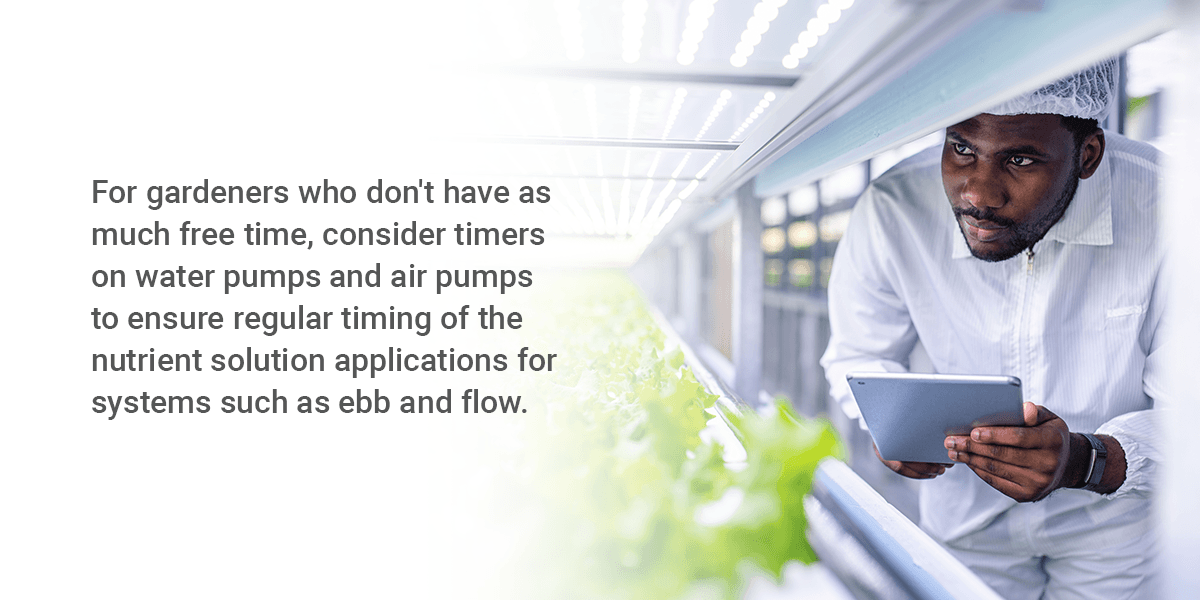
What Is the Best Hydroponic System?
Each type of hydroponic growing system has its own pros and cons. Therefore, the best hydroponic system is the one that works for you. If you take long vacations, you may not want to have an aeroponic system that will require regular monitoring of the pumps and manual spraying if the pumps fail. For gardeners who don’t have as much free time, consider timers on water pumps and air pumps to ensure regular timing of the nutrient solution applications for systems such as ebb and flow.
Always consider the type of plants you want to grow before setting up your system, too. NFT covered-channel systems cannot support large root systems. Therefore, these work best when growing leafy vegetables such as lettuce. Ebb and flow hydroponics can provide the needed root support for carrots and similar vegetables.
What Is the Easiest Hydroponic System to Use?
The easiest hydroponic system to use is either the DWC or the wick system. The DWC has a wider variety of plants you can grow. Plus, it only needs a means of aerating the nutrient solution. Wick systems don’t require power, making them a better option for areas that don’t have easy access to power outlets, such as in an outdoor shed or basement.
What Are the Components of a Hydroponic System?
Hydroponic systems have several components, depending on the specific method you choose. For instance, DWC must use air pumps, whereas NFT often does not require them. Always consider the specific type of hydroponic system before choosing components to build your own.
Media for Growing
The growing media is an inert substance that suspends the roots and supports the growing plant. Unlike soil, which also offers these benefits, growing media does not provide nutrients for the plant. However, it does help to hold moisture to keep the roots from drying out too quickly. Plus, many types of growing media have neutral pH values, which do not affect nutrient solution pH.
Some of the most popular types of growing media include the following:
- Vermiculite
- Perlite
- Expanded clay pellets
- Coconut coir
- Rockwool
- Grow rocks
The type of media you choose will vary based on the type of plants and hydroponic system. Remember, not all systems use growing media.
Net Pots or Hydroponic Containers
Net pots are not like standard plant pots. These containers for hydroponics help support the plant, especially when not using growing media. Their structure of openings at the bottom of the pot allows the roots to safely extend out for maximizing their exposure to the nutrient solution. Common types of hydroponic methods that use net pots include NFT and DWC.
Hydroponic containers also include fabric pots, and specialized plastic pots. These containers are either designed to allow nutrient solution to flow through openings in the pots, or the material itself allows solution to pass through as in the case of fabric pots. Common types of methods that use these containers include wick systems and flood tables.
Air Pumps and Air Stones
Air pumps and air stones are integral to oxygenating the water in DWC hydroponics. The air stone delivers the air from the pump to create bubbles in the reservoir. These bubbles contain oxygen the plants need to maintain their health.
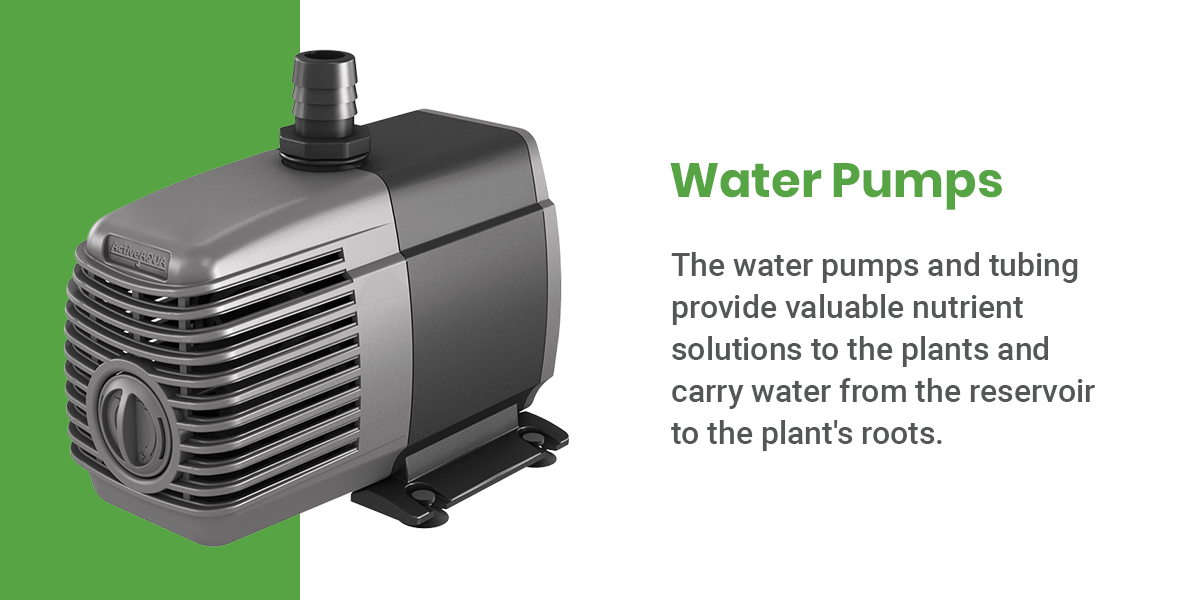
Water Pumps
The water pumps and tubing provide valuable nutrient solutions to the plants and carry water from the reservoir to the plant’s roots. These water pumps are components of ebb and flow, NFT and drip systems. In the ebb and flow systems, you should consider connecting the pump to a timer to reduce your effort and avoid forgetting to flood the system. Together with tubing, the water pumps are important for systems that rely on water carried from a reservoir to the plants.
Misting Systems and Drippers
For systems such as aeroponics that require misting the nutrient solution to the plants’ roots, misters or sprayers are vital. You must have misters that don’t clog and will provide enough solution to the plants. Additionally, for those who use drip systems, each plant needs a nutrient solution delivery method to slowly drip the liquid to the plant’s roots.
Pros and Cons of a Hydroponic System
Hydroponic systems can become one of the best investments you make. But you must consider the pros and cons of using this gardening method before starting.
Advantages of Hydroponics Systems
The pros of a hydroponic system include:
- Increased plant sizes: One of the biggest advantages of using hydroponics for growing is the ability to increase the plant size. Plants have better access to nutrients and water. Therefore, they often grow better than in outdoor gardens.
- A lack of pests: You don’t have to worry about outdoor pests when you grow inside. The savings on pesticides alone can make up for the additional cost of hydroponic equipment.
- Control over the growing environment: You don’t have to wait for a particular time of year to start your plants. For example, you can harvest strawberries in the fall instead of waiting for the spring. Plus, you can live in any sort of climate and still enjoy gardening. With hydroponics, you set up the lighting and more to take complete control over the plants’ growing conditions.
Disadvantages of Hydroponics Systems
Some things to keep in mind when considering a hydroponics system include:
- Initial setup of the equipment: While the setup requires some investment of time and money, it is not that different from the cost and time required to create outdoor flower beds or a greenhouse.
- Initial learning curve: Some beginners fail to move past the initial stages of setting up a system because they think it is too complicated or requires too much effort. However, compared to outdoor gardening, hydroponics requires about the same amount of time and effort to learn.
- Required plant monitoring: While outdoor gardening can be a little forgiving for those who forget to water, hydroponic gardening can have more serious consequences for owners who don’t carefully monitor their plants. If a single component of the system fails, such as a water pump, the entire harvest may die. Therefore, those who choose hydroponic gardening need to take extra precautions to monitor their systems and plants.
How Do You Build a Hydroponic System?
To create your own hydroponic system, you need to follow several steps for success, including:
1. Choose Your Plants
Decide the types of plants you want to grow. The plants will determine the type of hydroponic system you can successfully use. If you want to grow root vegetables like carrots, you should choose an ebb and flow system. For larger plants, consider a drip system, and for first-timers growing small, leafy plants, opt for a DWC system.
2. Select the Type of Hydroponic System
Once you know the plants you want to grow, choose the hydroponic system that will accommodate them. If you don’t know which types of plants you want but wish to experiment with hydroponics, consider a DWC to grow lettuce, spinach or other leafy greens.
3. Select a Reservoir
Choose a water reservoir to fit the type of hydroponic system you will use. For instance, you will need a deep container that can fit an air stone for DWC. For NFT systems, you will need a reservoir to fit under the larger growing bed fitted with channels for the nutrient solution.
4. Choose a Growing Medium or Net Pots
For systems that require grow media, choose the type of media needed. DWC and NFT use very little growing media and usually require net pots. Find the option that works with your hydroponic system.
5. Fit the Air or Water Pumps Into the Reservoir
If your system requires air pumps, such as a DWC, or a water pump, such as a drip system, get the type of pump your system needs.
6. Add the Plants and Nutrient Solution
Add the nutrient solution to the water and the plants to the system. The balance of nutrient solution depends on what you want to grow and varies by growth stage. Follow the mixing instructions on the nutrient solution packaging for specific information on how much to use. Always use purified water for your system to avoid contaminents and help prevent pH problems.
7. Install Lighting
Install grow lights in your indoor gardening area to provide adequate light for your plants.
8. Turn on the System
Turn on the pumps, lights and let the system supply your plants with the nutrients they need.
Find Hydroponics Systems at HTG Supply
Find all the supplies you need to set up a variety of hydroponics systems in your own home with HTG Supply. We make hydroponic gardening possible by providing home growers the equipment they need to succeed in their water-based, soilless growing efforts. Browse our selection at HTG Supply for common and hard-to-find hydroponics components.
